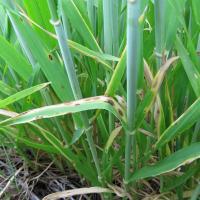Diagnosing wirrega blotch
A fungal foliar disease caused by Pyrenophora wirreganensis that primarily infects a range of grasses and can be found on paddock and road verges in spring. Leaf infections are rarely severe as spores produced on the leaves do not re-infect leaves and so do not increase the disease in crops.
What to look for
- Large elongated mid-brown blotches surrounded by a margin of pale tissue that frequently extends towards the leaf tip.
- Tissue at the centre of the blotch dies and in some cases a hole forms.
- The blotches expand and may eventually cover the entire leaf.
Plant
What else could it be
| Condition | Similarities | Differences |
|---|---|---|
| Diagnosing ring spot in cereals | Small round leaf lesions with a dark margin | Ring spot spots remain small and don't develop extensive yellow edges or streaking |
Where did it come from?

Grass weeds

Contaminated seed
- Spores from previously infected grass seed in the soil blow or are splashed on to leaves.
- Spores from these leaf infections do not affect other leaves, but infect florets.
- Seeds from infected grass florets do not germinate but fall to the ground to provide inoculum for the following year.
- Infections are worse where grass weeds were a problem in previous years.
Management strategies

Grass weed control

Grass pasture control
- Reduce grass weed burdens in previous crop or pasture phases.
- Reduce grasses, including barley and brome grass.
See also
Where to go for expert help
Page last updated: Friday, 17 April 2015 - 2:26pm




